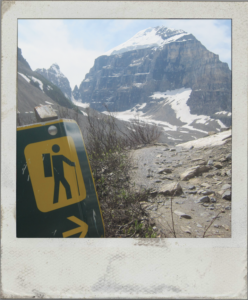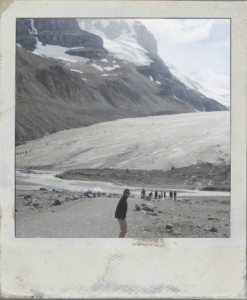There are many assumptions of what it means to be a Canadian. Jesse Colautti put some to the test on a road trip west across our own backyard.
Photos courtesy of Jesse Coulatti Four a.m. on the Trans-Canada Highway and I can barely keep my head off the steering wheel. I left Calgary more than three hours ago in hopes that I’d quickly find a campsite along the highway to sleep. Now I’m closing in on the Saskatchewan border, with only a half-empty bottle of Dr Pepper and my Cat Stevens album to keep me awake.I’m surrounded by immense darkness. A darkness devoid of other cars, street lights, or any other signs of life, and which seems to consume my meagre headlights. I try to focus on the yellow lines in front of me, but they begin to flicker. I close my eyes just for a second, and suddenly I’m startled by an unidentified spacecraft landing in the field to my right.
I wake up to the blast of a horn, and my car is on its way into the ditch at 100 km/h.
The movies had been wrong: My life didn’t flash before my eyes—only my recent spurt of bad decisions. Why would I have left Banff after 11 p.m. to find a place to sleep in Calgary, more than an hour away, when there were plenty of great camping sites to stay at? Why didn’t I check beforehand to see if this was the weekend of the Calgary Stampede? Why didn’t I just park at a Wal-Mart after I couldn’t find a hotel room?
Sometimes the lessons you can learn from a trip are only obvious in hindsight.
Rite of passage
For me, the cross-Canada road trip felt like a necessary coming-of-age moment. I felt I had do it. Perhaps it was the sheer size of our country, the simplicity of the path—most of Canada’s largest cities and sights can be found within a few hours of one trans-national highway—or a propensity for exploration and adventure in our perceived national identity.
But after completing two journeys from Ottawa to Vancouver the past two summers—I submit that I’m not a purist as I didn’t begin on the east coast—I’ve come to believe the real worth of the trip is to challenge such attempts to tie our country together. Driving across the country allows one to put to test the commonalities and stereotypes commercials will have us believe we share. After all, what do wheat fields, lush forests, and enormous mountains really have to do with kids from urban southern Ontario?
There’s more linking us together besides taxes, beer companies, and a favourite brand of coffee shops. You just have to get out the door to find out.
Testing street smarts in Saskatoon
Being the Luddite idealist that I am, I decided to forego technology in favour of street smarts and mostly obsolete printed maps. There’s something freeing about holding your finger up to a map and trying to figure out the best route from point A to point B. I remember telling a friend, “Leave the detailed routes and plans for family vacations. I’m going to just drive and figure it out on the way.”
For nearly 3,000 km the system worked great. But one evening, after arriving in Saskatoon, I decided to go see the newest Spiderman movie to unwind—as a film junky I didn’t consider it within the same category of technology I had decided to avoid. I grabbed a ticket for the 10:30 show, which left me two hours to explore Saskatoon and grab a bite to eat.
It was during this brief time that I fell in love with Saskatoon. Nestled right next to the Saskatchewan River, the city is gorgeous. And despite its exciting frontier vibe, there are neighbourhoods that feel extremely relaxed and charming. Fans of the Glebe in Ottawa would feel right at home.
I also immediately noticed a lack of urgency among the people of Saskatoon. Finally I’d found a place where the mall was open after 9 p.m. and where families were out on the streets together at 10 p.m.
I made my way back to the theatre 15 minutes before the movie and was amazed that there was no one in line yet for the film. Even more surprising was the look of bewilderment from an employee when I asked if I could go into the theatre. He told me the previous show was still going on. I thought, wow, I guess out here they don’t have to worry about cleaning up. I guess out in the Prairies people look after themselves.
Five minutes after the movie was supposed to start, I became annoyed. I’m relaxed as anyone, but the previous movie hadn’t even ended yet, making me wonder how anyone could manage in such a lawless land. After more blank looks from the employee, it was time to complain. I began to ask for the manager before I noticed the time on his watch didn’t match my own. It was exactly an hour ahead.
You can definitely make it across this country on nothing more than a few maps and brainpower, but make sure to still look into the details every once in a while. Stopping into a local information centre to find out if there are any events or festivals on, asking around for directions, or even just making sure you read up on time zones can really make the journey much smoother.
In search of profound moments
When I first told people I wanted to drive across the country by myself, they asked me if I needed somebody to talk to.
I knew it was a long trip, about 92 hours there and back—admittedly a long time to spend alone in a car. I figured it would be the best way to experience each moment to the fullest. I wouldn’t have anyone or anything to distract me from profound thoughts and feelings about the changing landscape around me. In doing so I could learn the most and have the purest Canadian adventure possible.
Then I drove through Northern Ontario.
Driving is very different than a long bus or train ride. I failed to consider that driving 15 hours through dense forest might feel a bit slow at times, and that during those times I couldn’t just read a book or close my eyes and listen to music. Beyond this, simple mundane tasks like passing, signalling, and turning were more exhausting than I imagined in such long stretches.
What kept me sane and alive were extremely ordinary things. Podcasts that made me laugh, random stops in Saskatchewan to stretch my legs and take photos, and unexpected tourist attractions—who knew Moose Jaw had tunnels underneath it used by Al Capone to bootleg liquor?—all made the drive more manageable.
What made the trip more fulfilling as a whole was when I stopped trying to understand things profoundly on my own and learned to spend more time getting to know other Canadians. In Banff, I hiked with a friend up a mountain that the information centre said was impossible for beginners. I couldn’t have done it without him. In Drumheller, Alta. I hung out with a family from Edmonton on vacation to take photos posing with some of the town’s giant dinosaur statues. In Thunder Bay, I spent time with a retired couple in front of Terry Fox’s monument and talked about his bravery, but also about their lives and the direction they saw the world going.
Identity
It’s one thing to put a label on who we are as a country, but when you make your way across this massive swath of land at 100 km/h you experience just how complex and varied it is.
The difference between a local bar in Toronto and one in Winnipeg, Calgary, or Vancouver is substantial, but hard to summarize. I hesitate to admit I spent most of my time in Vancouver debating movies, in Calgary oil and the environment, and in Winnipeg the bugs and weather, because there was so much more to my time in each place than that. There’s a particular feeling that goes along with each dot on the map.
I loved driving through Manitoba and seeing welcome signs citing which hockey players grew up in that town. Or the many moments while driving through Saskatchewan when I saw a horizon larger than I’d ever seen before, filled with canola and barren of human life. But I also loved eating Thai food in a diverse neighbourhood in Winnipeg, and taking selfies next to thousands of tourists in Banff and Vancouver. No single experience was more Canadian than the other. And no single person I met was more Canadian than the other.
My road trip taught me that Canadians are as diverse as the geography we live in. It challenged idealized and outdated understandings I had about national identity. Yet the beauty of the trip, and why everyone should do it before they die, is that it might teach you something completely different. Every trip across this country will take a different path involving unique experiences each time, but by the end of it you’ll have learned something. And perhaps if we all took a little more time learning about this country we’d have a better grasp of what it really is.
Alive. Alone. In a ditch.
Four-thirty a.m. on the side of the Trans-Canada Highway and my forehead rests on the steering wheel as adrenaline-filled clarity surges through me. I begin to laugh hysterically at myself. My ignorance, my assumptions, and my failure to embrace my surroundings had brought me to this moment, alone in a ditch somewhere I’ve never been, unscathed, yet humbled. Out of sheer chance I had driven into Calgary on one of the first days of its world famous Stampede and I had kept driving. All because I had some fixed idea on where I needed to be in the morning, all because the Stampede was never part of the plan.
When road tripping across this country, you are bound to make mistakes. Some of these mistakes may cost you a moment well spent. Others might risk your life.
Six hours later I check out of a motel just outside of Medicine Hat, take a few deep breaths, and return to the road. The road across this country is Iong—long enough for redemption, and long enough to gain a new perspective. You just have to let go and let it lead you somewhere you hadn’t planned.









